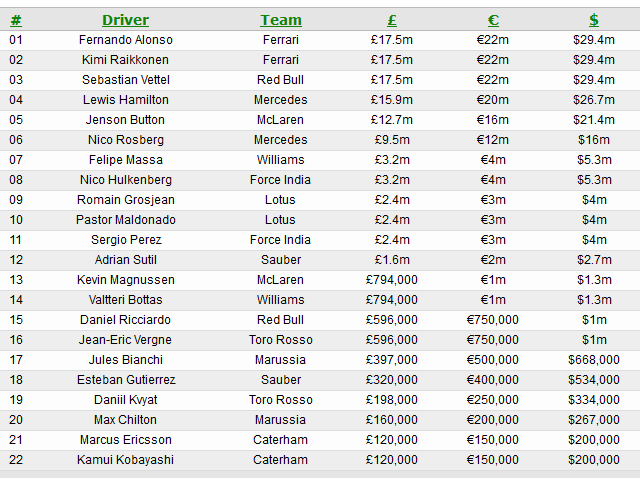
Here’s a sample article about F1 driver salaries. Remember that exact figures are often kept private and estimations vary across sources. This article focuses on providing context and analysis rather than claiming definitive numbers.
F1 Driver Salaries: A Deep Dive into the World’s Highest-Paid Racers
Formula 1 racing is a spectacle of speed, skill, and immense pressure. But beyond the roar of the engines and the thrill of the race, lies a world of staggering wealth, particularly for the drivers who risk it all on the track. Understanding the complexities of F1 driver salaries requires examining a multifaceted system influenced by performance, team success, sponsorships, and individual negotiating power. While precise figures remain largely confidential, analyzing available data paints a vivid picture of the financial landscape of this elite sport.
The Top Tier: The Multi-Million Dollar Club
At the apex of the F1 salary structure sit the sport’s superstars. Drivers like Lewis Hamilton and Max Verstappen, consistent championship contenders and global icons, command salaries in the tens of millions of dollars annually. Their earning power isn’t solely dependent on their base salary from their teams. These drivers are global brands, leveraging their fame and influence through lucrative sponsorship deals with major corporations. Their image is a valuable commodity, attracting endorsements from luxury watchmakers, clothing brands, and technology companies. These endorsements significantly boost their overall income, often exceeding their base salary from the team.
The impact of championship wins is undeniable. A world championship title translates to increased marketability, leading to more lucrative sponsorship deals and a stronger negotiating position in future contract negotiations. Therefore, the salary of a champion driver isn’t just a reflection of their on-track performance; it’s a testament to their overall brand value and influence.
The Mid-Field Battle: A Range of Earning Potential
The middle tier of F1 drivers represents a diverse range of earning potential. While these drivers may not command the astronomical salaries of the top tier, their earnings still fall comfortably into the multi-million dollar bracket. Their salaries are influenced by factors such as their past performance, consistency, and potential to contribute to the team’s overall success. Teams are willing to invest in drivers who consistently deliver points and contribute to the team’s championship aspirations. Moreover, the team’s own financial standing plays a crucial role. Larger, more financially stable teams can afford to pay higher salaries to attract and retain top talent.
This segment also includes drivers who are transitioning from junior series or are relatively new to the sport. Their salaries often reflect their potential and the team’s assessment of their future value. Teams might offer lower initial salaries with performance-based incentives to reward progress and success. The structure of these contracts encourages drivers to strive for better performance, ultimately benefitting both the driver and the team.
The Rising Stars and the Future of F1 Salaries
The emergence of young, talented drivers constantly reshapes the F1 salary landscape. Teams are often willing to invest in promising young drivers, recognizing their future potential. These drivers might initially receive lower salaries than established racers, but their potential for growth attracts lucrative sponsorship opportunities and the prospect of significantly higher future earnings. The financial risk taken by teams is often rewarded with the prospect of having a driver who develops into a world champion, generating significant returns on investment.
The future of F1 salaries is intrinsically linked to the sport’s continued growth and globalization. The expansion into new markets and the increasing popularity of F1 globally will likely lead to higher sponsorship revenue, enabling teams to offer even more competitive salaries to attract and retain the best drivers. The growing influence of social media and digital platforms also enhances the marketability of F1 drivers, creating new avenues for revenue generation through endorsements and personal branding initiatives.
Factors Influencing F1 Driver Salaries
Several key factors influence the salary of an F1 driver:
- Performance: This is the most crucial factor. Consistent strong performances, podium finishes, and race wins significantly increase a driver’s value.
- Championship Wins: Winning a World Championship dramatically boosts a driver’s marketability and salary potential.
- Team Success: Drivers on successful teams often command higher salaries, reflecting the team’s overall brand value and marketability.
- Sponsorships: Endorsement deals can significantly augment a driver’s overall income, often exceeding their base salary.
- Experience and Track Record: A proven track record in the sport increases a driver’s negotiating power.
- Negotiating Power: A driver’s agent plays a critical role in securing favorable contract terms.
- Team Budget: The financial resources of the team directly impact the salaries they can offer.
Conclusion: A Dynamic and Evolving Landscape
The world of F1 driver salaries is dynamic and complex. While precise figures remain elusive, it’s clear that the sport’s top drivers earn multi-million dollar salaries, reflecting their performance, marketability, and contribution to the sport’s global popularity. The future of F1 salaries is likely to see continued growth, driven by factors such as the sport’s expanding global reach, increased sponsorship revenue, and the emergence of new driving talents. The intricate interplay of performance, brand value, and negotiation will continue to shape the financial landscape of this high-stakes, high-reward sport for years to come.



